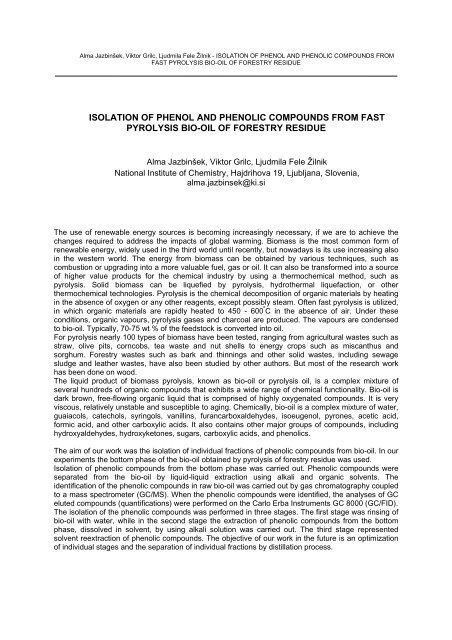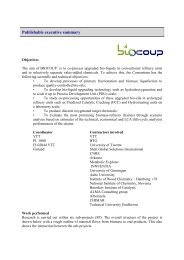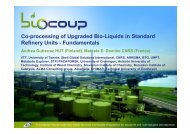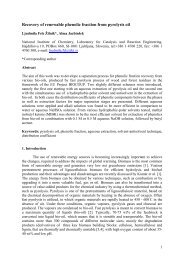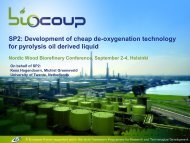Isolation of phenol and phenolic compounds from fast - Biocoup
Isolation of phenol and phenolic compounds from fast - Biocoup
Isolation of phenol and phenolic compounds from fast - Biocoup
You also want an ePaper? Increase the reach of your titles
YUMPU automatically turns print PDFs into web optimized ePapers that Google loves.
Alma Jazbinšek, Viktor Grilc, Ljudmila Fele Žilnik - ISOLATION OF PHENOL AND PHENOLIC COMPOUNDS FROM<br />
FAST PYROLYSIS BIO-OIL OF FORESTRY RESIDUE<br />
ISOLATION OF PHENOL AND PHENOLIC COMPOUNDS FROM FAST<br />
PYROLYSIS BIO-OIL OF FORESTRY RESIDUE<br />
Alma Jazbinšek, Viktor Grilc, Ljudmila Fele Žilnik<br />
National Institute <strong>of</strong> Chemistry, Hajdrihova 19, Ljubljana, Slovenia,<br />
alma.jazbinsek@ki.si<br />
The use <strong>of</strong> renewable energy sources is becoming increasingly necessary, if we are to achieve the<br />
changes required to address the impacts <strong>of</strong> global warming. Biomass is the most common form <strong>of</strong><br />
renewable energy, widely used in the third world until recently, but nowadays is its use increasing also<br />
in the western world. The energy <strong>from</strong> biomass can be obtained by various techniques, such as<br />
combustion or upgrading into a more valuable fuel, gas or oil. It can also be transformed into a source<br />
<strong>of</strong> higher value products for the chemical industry by using a thermochemical method, such as<br />
pyrolysis. Solid biomass can be liquefied by pyrolysis, hydrothermal liquefaction, or other<br />
thermochemical technologies. Pyrolysis is the chemical decomposition <strong>of</strong> organic materials by heating<br />
in the absence <strong>of</strong> oxygen or any other reagents, except possibly steam. Often <strong>fast</strong> pyrolysis is utilized,<br />
in which organic materials are rapidly heated to 450 - 600 º C in the absence <strong>of</strong> air. Under these<br />
conditions, organic vapours, pyrolysis gases <strong>and</strong> charcoal are produced. The vapours are condensed<br />
to bio-oil. Typically, 70-75 wt % <strong>of</strong> the feedstock is converted into oil.<br />
For pyrolysis nearly 100 types <strong>of</strong> biomass have been tested, ranging <strong>from</strong> agricultural wastes such as<br />
straw, olive pits, corncobs, tea waste <strong>and</strong> nut shells to energy crops such as miscanthus <strong>and</strong><br />
sorghum. Forestry wastes such as bark <strong>and</strong> thinnings <strong>and</strong> other solid wastes, including sewage<br />
sludge <strong>and</strong> leather wastes, have also been studied by other authors. But most <strong>of</strong> the research work<br />
has been done on wood.<br />
The liquid product <strong>of</strong> biomass pyrolysis, known as bio-oil or pyrolysis oil, is a complex mixture <strong>of</strong><br />
several hundreds <strong>of</strong> organic <strong>compounds</strong> that exhibits a wide range <strong>of</strong> chemical functionality. Bio-oil is<br />
dark brown, free-flowing organic liquid that is comprised <strong>of</strong> highly oxygenated <strong>compounds</strong>. It is very<br />
viscous, relatively unstable <strong>and</strong> susceptible to aging. Chemically, bio-oil is a complex mixture <strong>of</strong> water,<br />
guaiacols, catechols, syringols, vanillins, furancarboxaldehydes, isoeugenol, pyrones, acetic acid,<br />
formic acid, <strong>and</strong> other carboxylic acids. It also contains other major groups <strong>of</strong> <strong>compounds</strong>, including<br />
hydroxyaldehydes, hydroxyketones, sugars, carboxylic acids, <strong>and</strong> <strong>phenol</strong>ics.<br />
The aim <strong>of</strong> our work was the isolation <strong>of</strong> individual fractions <strong>of</strong> <strong>phenol</strong>ic <strong>compounds</strong> <strong>from</strong> bio-oil. In our<br />
experiments the bottom phase <strong>of</strong> the bio-oil obtained by pyrolysis <strong>of</strong> forestry residue was used.<br />
<strong>Isolation</strong> <strong>of</strong> <strong>phenol</strong>ic <strong>compounds</strong> <strong>from</strong> the bottom phase was carried out. Phenolic <strong>compounds</strong> were<br />
separated <strong>from</strong> the bio-oil by liquid-liquid extraction using alkali <strong>and</strong> organic solvents. The<br />
identification <strong>of</strong> the <strong>phenol</strong>ic <strong>compounds</strong> in raw bio-oil was carried out by gas chromatography coupled<br />
to a mass spectrometer (GC/MS). When the <strong>phenol</strong>ic <strong>compounds</strong> were identified, the analyses <strong>of</strong> GC<br />
eluted <strong>compounds</strong> (quantifications) were performed on the Carlo Erba Instruments GC 8000 (GC/FID).<br />
The isolation <strong>of</strong> the <strong>phenol</strong>ic <strong>compounds</strong> was performed in three stages. The first stage was rinsing <strong>of</strong><br />
bio-oil with water, while in the second stage the extraction <strong>of</strong> <strong>phenol</strong>ic <strong>compounds</strong> <strong>from</strong> the bottom<br />
phase, dissolved in solvent, by using alkali solution was carried out. The third stage represented<br />
solvent reextraction <strong>of</strong> <strong>phenol</strong>ic <strong>compounds</strong>. The objective <strong>of</strong> our work in the future is an optimization<br />
<strong>of</strong> individual stages <strong>and</strong> the separation <strong>of</strong> individual fractions by distillation process.
Alma Jazbinšek, Viktor Grilc, Ljudmila Fele Žilnik - ISOLATION OF PHENOL AND PHENOLIC COMPOUNDS FROM<br />
FAST PYROLYSIS BIO-OIL OF FORESTRY RESIDUE<br />
1. Introduction<br />
BIOCOUP is a European project that unites different universities, research centres <strong>and</strong><br />
industrial companies. BIOCOUP project is supported through the six framework programme<br />
for research <strong>and</strong> technological development:<br />
- SP1: Primary Liquefaction. Improve the quality <strong>of</strong> the primary oil <strong>and</strong> reduce production<br />
costs.<br />
- SP2: Bio-liquid upgrading. Research <strong>and</strong> development <strong>of</strong> various upgrading-deoxygenation<br />
technologies.<br />
- SP3: Co-processing in st<strong>and</strong>ard refinery. Assessment <strong>of</strong> co-processing upgraded bioliquids<br />
in st<strong>and</strong>ard refinery equipment.<br />
- SP4: Conversion. Identification <strong>and</strong> technology development to obtain discrete target<br />
<strong>compounds</strong> <strong>from</strong> the bio-liquids.<br />
- SP5: Scenario analysis. Identification <strong>and</strong> assessment <strong>of</strong> the most promising biomass-torefinery<br />
chain(s) on basis <strong>of</strong> predicted technical, economical <strong>and</strong> LCA-performances.<br />
- SP6: Transversal activities. Coordination <strong>of</strong> the project, analytical support to all the partners<br />
in the consortium <strong>and</strong> dissemination <strong>of</strong> the knowledge generated within BIOCOUP.<br />
Biomass<br />
SP1<br />
Primary Liquefaction<br />
SP2<br />
Bio-liquid upgrading<br />
SP5 Scenario analysis<br />
SP6 Transversal activities<br />
Figure 1. BIOCOUP sub-projects structure<br />
SP3<br />
Co-procesing in<br />
petroleum refinery<br />
SP4<br />
Conversion<br />
Conventional fuels<br />
<strong>and</strong> chemicals<br />
Oxygenated<br />
products<br />
Bio-oil, gained <strong>from</strong> biomass with <strong>fast</strong> pyrolysis, can be used as fuel. It can also be<br />
transformed into a source <strong>of</strong> higher value products for the chemical industry. Final upgraded<br />
products must be suited to be co-processed in existing refinery units.<br />
Bio-oil differs <strong>from</strong> fossil fuels over large content <strong>of</strong> water, oxygen <strong>and</strong> corrosiveness. These<br />
properties make the co-processing <strong>of</strong> bio-oil in st<strong>and</strong>ard refineries impossible. Bio-oil needs<br />
to be upgraded. One <strong>of</strong> the upgrading processes considered within BIOCOUP is<br />
hydrodeoxygenation (HDO) <strong>of</strong> <strong>fast</strong> pyrolysis oil (PO). In this process, oxygen is removed<br />
<strong>from</strong> oxygenated hydrocarbons in the form <strong>of</strong> water using hydrogen <strong>and</strong> a catalyst. 1<br />
National Institute <strong>of</strong> Chemistry, Slovenia is engaged in a sub-project SP4 with a purpose to<br />
identify <strong>and</strong> develop technology to obtain different <strong>phenol</strong>ic <strong>compounds</strong> or fractions <strong>from</strong> the<br />
bio-oil.<br />
Various types <strong>of</strong> biomass can be used to produce bio-oil. For the experiments described in<br />
this paper we used bio-oil produced with <strong>fast</strong> pyrolysis at about 520°C <strong>from</strong> the forest<br />
residue. The forestry residue pyrolysis liquid separates immediately after a condensation to a<br />
polar, liquid bottom phase (80-90 wt %) <strong>and</strong> a hydrophobic viscous top phase (10-20 wt %).
Alma Jazbinšek, Viktor Grilc, Ljudmila Fele Žilnik - ISOLATION OF PHENOL AND PHENOLIC COMPOUNDS FROM<br />
FAST PYROLYSIS BIO-OIL OF FORESTRY RESIDUE<br />
The amount <strong>and</strong> composition <strong>of</strong> the top phase are affected by the feedstock (wood species,<br />
amount <strong>of</strong> needles, feedstock storage time), pyrolysis <strong>and</strong> recovery <strong>of</strong> product. 2 Liquid yields<br />
(organic+water) <strong>from</strong> forestry residue ranged <strong>from</strong> 59 to 64 wt % <strong>of</strong> dry feed <strong>and</strong> the yield for<br />
pine sawdust was about 74 wt % (Figure 2).<br />
Yield (%)<br />
80<br />
70<br />
60<br />
50<br />
40<br />
30<br />
Brown forest<br />
residue<br />
Green forest<br />
residue<br />
Pine sawdust<br />
Water 13,1 11,2 10,3<br />
Organic 48 53,3 64,1<br />
Figure 2: Liquid yields for pyrolysis liquids <strong>from</strong> brown <strong>and</strong> green forestry residue <strong>and</strong> pine. 2<br />
The water-soluble fraction (22 wt % <strong>of</strong> water) <strong>of</strong> green forestry residue liquid contained about<br />
1 wt % <strong>of</strong> alcohols (methanol) <strong>and</strong> 6 wt % <strong>of</strong> low-molecular-mass carboxylic acids, <strong>of</strong> which<br />
the share <strong>of</strong> acetic <strong>and</strong> formic acids was 90%. The bottom phase contained also aldehydes,<br />
ketones, <strong>phenol</strong>ic <strong>compounds</strong>, sugars, lignins, etc.<br />
2. Experimental<br />
The objective <strong>of</strong> our work is the isolation <strong>of</strong> individual fractions <strong>of</strong> <strong>phenol</strong>ic <strong>compounds</strong> <strong>from</strong><br />
bio-oil, gained with pyrolysis <strong>of</strong> the forestry residue.<br />
The qualitative analyses <strong>of</strong> the bottom phase <strong>of</strong> bio-oil obtained by pyrolysis <strong>of</strong> the forestry<br />
residues were performed on Agilent GC (6890N)-MSD (5973N) chromatograph with split<br />
injection. We identified a number <strong>of</strong> <strong>phenol</strong>ic <strong>compounds</strong> <strong>and</strong> the final quantitative<br />
determinations were performed on Carlo Erba Instruments GC 8000 (GC/FID).<br />
A feasible separation route to isolate <strong>phenol</strong>ic fractions <strong>from</strong> bio-oil was investigated. The<br />
addition <strong>of</strong> a certain amount <strong>of</strong> water to bio-oil was used to remove the water <strong>from</strong> the bottom<br />
phase <strong>of</strong> the bio-oil. The phase split was initiated <strong>and</strong> two phases occurred, namely bottom<br />
phase, very viscous, dark phase that represented 25% <strong>of</strong> the total amount <strong>and</strong> upper<br />
aqueous phase, transparently brown, that represented 75%.<br />
The formed bottom phase was dissolved in a solvent <strong>and</strong> further contacted with a basic<br />
solution. After the separation <strong>of</strong> the phases, the evaporation <strong>of</strong> the major amount <strong>of</strong> solvent<br />
took place.<br />
The <strong>phenol</strong>ic <strong>compounds</strong> that remained in the basic phase were recovered by acidifying the<br />
solution, followed by solvent re-extraction.
Alma Jazbinšek, Viktor Grilc, Ljudmila Fele Žilnik - ISOLATION OF PHENOL AND PHENOLIC COMPOUNDS FROM<br />
FAST PYROLYSIS BIO-OIL OF FORESTRY RESIDUE<br />
3. Results <strong>and</strong> discussion<br />
As it was mentioned, we identified a number <strong>of</strong> different <strong>phenol</strong>ic <strong>compounds</strong> in the bottom<br />
phase <strong>of</strong> the bio-oil. Figure 3 shows the largest peaks <strong>of</strong> <strong>phenol</strong>ic <strong>compounds</strong>.<br />
Figure 3: Chromatogram <strong>of</strong> the bottom phase <strong>of</strong> bio-oil<br />
The peak <strong>of</strong> acetovanillone on Figure 3 is partial covered with another peak <strong>of</strong> levoglucosan.<br />
After an addition <strong>of</strong> water to the phase, this sugar <strong>and</strong> other water soluble substances<br />
partitioned to an aqueous phase, <strong>and</strong> the <strong>phenol</strong>ic <strong>compounds</strong> were concentrated in the<br />
bottom organic phase (Figure 4)<br />
When the new formed bottom phase was contacted with the basic solution, the <strong>phenol</strong>ic<br />
<strong>compounds</strong>, with lower pKA were concentrated in an aqueous phase. The majority <strong>of</strong> the<br />
<strong>phenol</strong>ic <strong>compounds</strong> remained in an organic phase.
wt%<br />
Alma Jazbinšek, Viktor Grilc, Ljudmila Fele Žilnik - ISOLATION OF PHENOL AND PHENOLIC COMPOUNDS FROM<br />
FAST PYROLYSIS BIO-OIL OF FORESTRY RESIDUE<br />
0,45%<br />
0,40%<br />
0,35%<br />
0,30%<br />
0,25%<br />
0,20%<br />
0,15%<br />
0,10%<br />
0,05%<br />
0,00%<br />
Bottom phase <strong>of</strong> biooil<br />
after rinsing with water<br />
p-cresol guaiacol creosol 4- eugenol vannilin isoeug. aceto<br />
ethylguaiacol<br />
vanilone<br />
Figure 4: Comparison <strong>of</strong> <strong>phenol</strong>ic <strong>compounds</strong> concentrations in the lower phase before <strong>and</strong><br />
after washing out with water.<br />
Figure 5 shows a chromatogram <strong>of</strong> a mixture <strong>of</strong> <strong>phenol</strong>ic <strong>compounds</strong> after the contact with<br />
the basic solution <strong>and</strong> partial evaporation <strong>of</strong> a solvent. The comparison <strong>of</strong> the Figures 3 <strong>and</strong><br />
5 shows that after the contact with the basic solution <strong>and</strong> partial evaporation <strong>of</strong> the solvent<br />
mainly the <strong>phenol</strong>ic <strong>compounds</strong> remained <strong>and</strong> all other substances were almost removed.<br />
Figure 5: Chromatogram <strong>of</strong> a mixture <strong>of</strong> <strong>phenol</strong>ic <strong>compounds</strong> after the contact with the basic<br />
solution <strong>and</strong> partial evaporation <strong>of</strong> the solvent<br />
Figure 6 shows the increase <strong>of</strong> a concentration <strong>of</strong> <strong>phenol</strong>ic <strong>compounds</strong> after contact with<br />
basic solution <strong>and</strong> partial evaporation <strong>of</strong> solvent.
wt%<br />
Alma Jazbinšek, Viktor Grilc, Ljudmila Fele Žilnik - ISOLATION OF PHENOL AND PHENOLIC COMPOUNDS FROM<br />
FAST PYROLYSIS BIO-OIL OF FORESTRY RESIDUE<br />
1,80%<br />
1,60%<br />
1,40%<br />
1,20%<br />
1,00%<br />
0,80%<br />
0,60%<br />
0,40%<br />
0,20%<br />
0,00%<br />
Bottom phase <strong>of</strong> biooil<br />
af ter contact with basic solution <strong>and</strong><br />
partial ev aporation <strong>of</strong> solv ent<br />
p-cresol guaiacol creosol 4- eugenol vannilin isoeug. aceto<br />
ethylguaiacol<br />
vanilone<br />
Figure 6: Comparison <strong>of</strong> <strong>phenol</strong>ic <strong>compounds</strong> concentration between un-processed bottom<br />
phase <strong>of</strong> bio oil <strong>and</strong> a mixture <strong>of</strong> <strong>phenol</strong>ic <strong>compounds</strong> after the contact with the basic solution<br />
<strong>and</strong> partial evaporation <strong>of</strong> solvent.<br />
The investigation <strong>of</strong> a feasible separation route to isolate <strong>phenol</strong>ic <strong>compounds</strong> or fractions is<br />
in progress. The objective <strong>of</strong> our future work is an optimization <strong>of</strong> individual stages <strong>and</strong> the<br />
separation <strong>of</strong> individual fractions by distillation process.<br />
5. References<br />
1. F.M. Mercadera, A. Ardiyantib, A. Gutierrezc, S. Khromovad, E. Leijenhorste, S. Kerstena,<br />
K. Hogendoorna, W. Prinse, M. Groenevelda; Upgrading <strong>of</strong> bio-liquids for co-processing in<br />
st<strong>and</strong>ard refinery units; 19th EU Contest for Young Scientists, Valencia, Spain, September<br />
2007<br />
2. A. Oasmaa, E. Kuoppala <strong>and</strong> Y. Solantausta, Fast pyrolysis <strong>of</strong> forestry residue. 2.<br />
Physochemical Composition <strong>of</strong> product Liquid, Energy & Fuels 2003,17, 433-443<br />
Acknowledgement<br />
The financial support <strong>from</strong> the EU project BIOCOUP 518312 is gratefully acknowledged.


